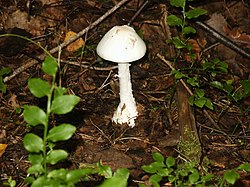Amanita virosa
| Destroying Angel | |
|---|---|

| |
Secure
| |
| Scientific classification | |
| Kingdom: | |
| Division: | |
| Class: | |
| Subclass: | |
| Order: | |
| Family: | |
| Genus: | |
| Species: | A. virosa
|
| Binomial name | |
| Amanita virosa (Fr.) Bertillon
| |
| Amanita virosa | |
|---|---|
| Gills on hymenium | |
| Cap is convex or flat | |
| Hymenium is free | |
| Stipe has a ring and volva | |
| Spore print is white | |
| Ecology is mycorrhizal | |
| Edibility is deadly | |
Amanita virosa, commonly known as the destroying angel, is a poisonous basidiomycete fungus, one of many in the genus Amanita. Occurring in Europe, A. virosa associates with various deciduous and coniferous trees. The large fruiting bodies (i.e., the mushrooms) appear in summer and autumn; the caps, stipes and gills are all white in colour.
Immature specimens of A. virosa resemble several edible species commonly consumed by humans, increasing the risk of accidental poisoning. A. virosa is one of the most poisonous of all known toadstools, its principal toxic constituent α-amanitin, which damages the liver and kidneys, often fatally. No antidote is known.
Taxonomy and naming
The common name of destroying angel is applied to several all-white species of poisonous Amanita; this species in Europe and to Amanita bisporiga in eastern North America, and A. ocreata in the west. A. virosa was first collected and described by Elias Magnus Fries in Sweden. Its specific epithet virosa derived from the Latin term virōsus 'stinking' or 'foetid'.[1]
Description
A. virosa first appears as a a white egg-shaped object covered with a universal veil. As it grows, the mushroom breaks free, though there may be ragged patches of veil at the cap edges. The cap is initially conical with inturned edges, before becoming hemispherical and flattening with a diameter up to 12 cm (4½ in). Caps often have a distinctive boss. It is able to be peeled and white, though the centre may be ivory in colour. The crowded free gills are white, as is the stipe and volva. The thin stipe is up to 15 cm (6 in) tall, with a hanging grooved ring. The spore print is white and the spores egg-shaped conical and 7-10 μm long. They stain blue with iodine. The flesh is white and the taste reminiscent of radishes, and turns bright yellow with sodium hydroxide.[2]
This fungus highlights the danger of picking immature fungi as it resembles the edible mushrooms Agaricus arvensis and A. campestris, and the puffballs (Lycoperdon spp. ) before the caps have opened and the gills visible.
Distribution and habitat
It is found in mixed woodland, especially in association with beech, on mossy ground in summer and autumn.[2] All Amanita species form ectomycorrhizal relationships with the roots of certain trees.
Toxicity
Amanita virosa is highly toxic, and has been responsible for severe mushroom poisonings.[3] Like the closely related death cap (A. phalloides), it contains the highly toxic amatoxins, as well as phallotoxins.
References
- ^ Simpson, D.P. (1979). Cassell's Latin Dictionary (5 ed.). London: Cassell Ltd. p. 883. ISBN 0-304-52257-0.
- ^ a b Zeitlmayr, Linus (1976). Wild Mushrooms:An Illustrated Handbook. Hertfordshire: Garden City Press. pp. p. 62-63. ISBN 0-584-10324-7.
{{cite book}}:|pages=has extra text (help) - ^ Benjamin.p200
Sources
- Benjamin, Denis R. (1995). Mushrooms: poisons and panaceas — a handbook for naturalists, mycologists and physicians. New York: WH Freeman and Company. ISBN 0-7167-2600-9.
